(As told to Alan Mitchell by Leon White)
PHOTO ABOVE: Long-time friends Alan Mitchell (second from left) and Leon White (right) at Port Orford City Hall.
I had never imagined becoming Mayor because I did not think I could be elected. Then one work day at my job in the office of the Western States Plywood Cooperative on Elk River, I got a phone call from Mayor Adolph Windmaiser telling me there was an empty seat on the City council. He asked if I would allow him to put my name on the ballot. He said he would handle the paperwork required. I was so surprised. I paused, thought about it a bit, then cautiously answered “Yes”. When the election came around, I discovered I was unopposed!

That was in September. I was elected for a term in office that began in January. Sometime before January, Mayor Windmaiser died and the Council members appointed one of their own, Jim Peterson, as Mayor. He was Mayor when I attended my first Council meeting. A couple of months later, the position of Mayor had become open after Jim Peterson had sold his grocery store and relocated to Eastern Oregon.
Before the meeting to fill that position, City Councilman Kent Wagner had phoned me at home to ask if I would accept appointment by the Council as Mayor. Kent told me another Councilman, Dick Goergen, would be seconding the appointment. Once again, I was so surprised. I told Kent I would have to think a little bit about this. I decided to accept because I had been born and lived my entire life in Port Orford. It was my Community and I wanted the best for it.
At the next Council meeting, I was appointed and took the Mayor’s seat at the Council Table. Once seated, the first thing I told everyone was “I hope I will not let you down.”
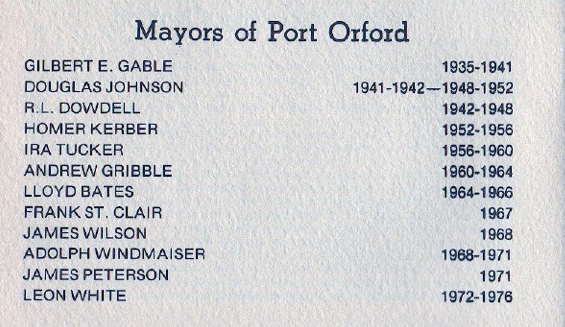
When I became Mayor, I was pleased to learn those who had served before me had done well. The Government was already in good shape. I was fortunate during my term to be able to add to that with a series of projects that have had long term benefit to Port Orford.
I am not a thinker of new ideas, but I recognized that when good ideas were presented to me, I needed to use my new position as Mayor to support them. I needed to encourage the City Council to take the necessary actions to move forward.
The office of City Mayor is interesting when you realize it has little authority by itself. It is the six Council members who have the authority. They make the motions and take votes for or against them. The Mayor cannot make motions, second them or vote on them, unless there is a tie vote. Only when a tie vote happens can the Mayor cast a vote.
I recall that Port Orford’s City Council cannot meet and do business unless a quorum of at least 4 Councilpersons are present. The Mayor’s presence does not count towards a quorum. I was impressed with how well this form of City Government, with its limited power of the office of Mayor, worked.
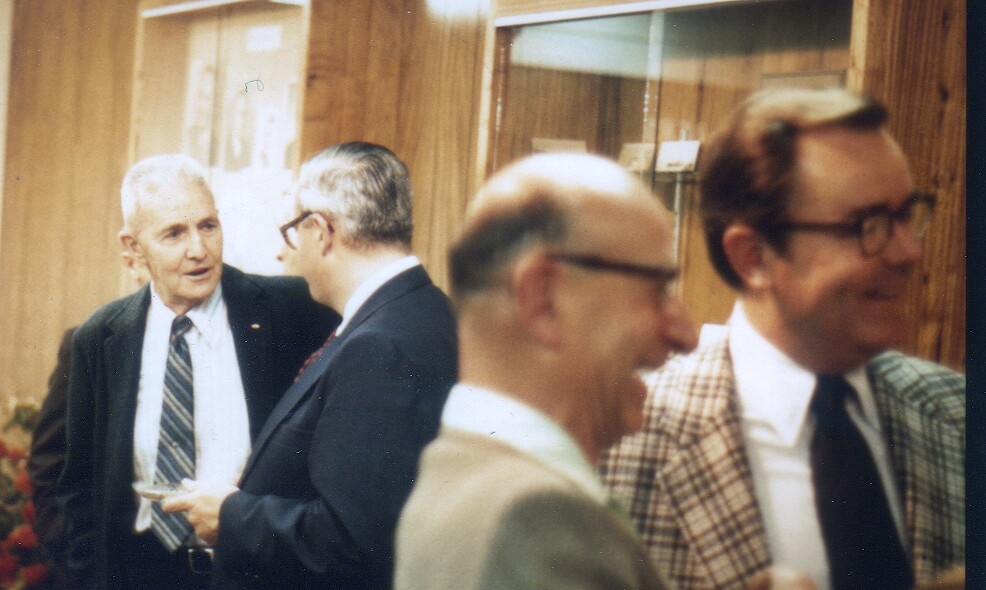
During my time in office there was mostly similar thinking. Nearly all motions made were seconded and passed. Amazingly, there were hardly any motions that received even one “No” vote. Maybe it helped that I tried to encourage thorough discussions before a motion was made. The downside was that could take a lot of time. Fortunately, I had a Councilman who was really good – in a diplomatic way – of signaling me when he thought it was time for us to move on. Harold Robinson would catch my eye while rolling his hands over each other. That was his polite way of saying “Mr. Mayor, Wind It Up!”.
I was also fortunate that when I became Mayor, I had 6 Council members who worked well with one another: Kent Wagner; Dick Goergen; Harold Robinson; Goerge Gehrke; Delbert Neal; and Aileen Smith. Kent owned and operated a commercial fishing boat and a D-6 Cat bulldozer for land clearing. Dick Goergen developed property. Harold Robinson worked as a custodian for the school district. Delbert Neal owned and operated the town’s only Variety Store and had been a Western States Plywood shareholder. Aileen Smith was a real estate broker.
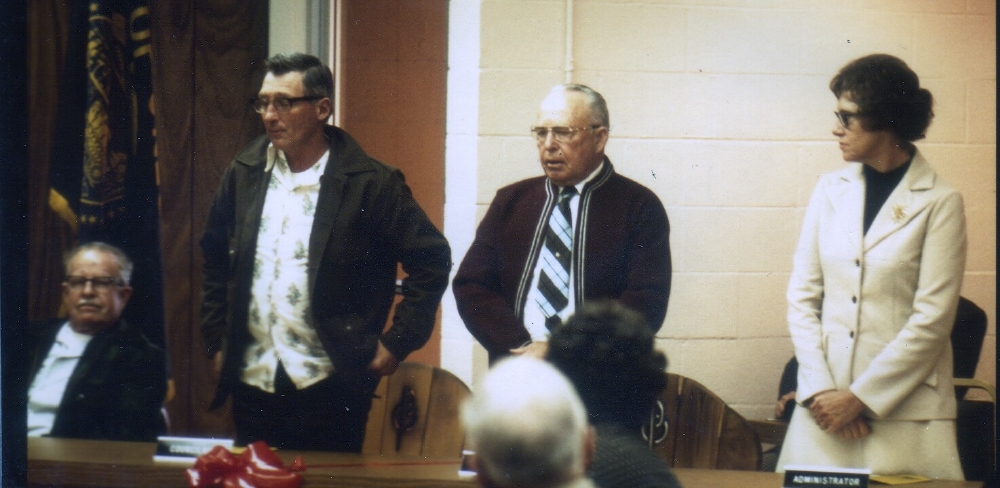
45 years ago when I was Mayor, we had no microphone for the public but they were seated in front of us so they could overhear everything. We did not have a tape recorder; instead we had a City Recorder to take and writeup the minutes of our meetings. Also in attendance would be our City’s Attorney. His role was to evaluate the legality of all proposed actions and tell us what our options might be. We also had a Justice of the Peace – Georgia Dougherty.
We had residents who served year-round on our Planning Commission. There were other residents who served on our Budget Committee to annually create a budget for the City Council and Mayor to consider.
Vital City Employees
During my tenure I was fortunate to work with several excellent city employees who kept the City operational. They include, but are not limited to:
VERNITA LONGTON (wife of a Western States shareholder) was Bookkeeper and later promoted to Administrator/Bookkeeper. She did an excellent job of coodinating all of the City’s Departments and preparing monthly reports for the City Council. Our City was small with only two other Departments.
Public Works Department (Water-Sewer-Streets): VERN SONDERMAN (former Western States Plywood shareholder) was department head and DON COBLE (former commercial fisherman) was his assistant.
Police Department: Chief of Police was JACK WALDIE (former Western States Plywood shareholder).
The City had a large, recently built modern building at 20th and Idaho so it could consolidate its Office, Council Chambers, Police Station, Fire Hall and Ambulance garage. Both the Fire Department and Ambulance Association were totally staffed by volunteers and vital to the City’s safety.

When I began my term as Mayor I was pleased to find many good projects already moving forward. I kept them moving and then initiated a few new ones:
Port Orford’s First Comprehensive Plan
The City of Port Orford Government approved and accepted the State of Oregon’s then new LCDC (Land Conservation and Development Commission) advice to begin to implement the new law. Oregon was offering to pay all of legal and planning expenses necessary for us to work our way through the process. Cities with LCDC-approved Plans were going to be given preference for future financial grants. A key part of the planning process included the designation of land to the north, east and south of the City as an Urban Growth Boundary. After our Comprehensive Plan was accepted by the State, properties within the boundary would be guaranteed to be allowed to be urbanized as needed. Adoption of our plan also guaranteed that lands outside of our Urban Growth Boundary would be allowed to remain as open farmlands and open space.
I believe Port Orford’s Comprehensive Plan was one of the first to be approved by the State of Oregon. In the year this happened the League of Oregon Cities named Port Orford the best Oregon City for communities of our size and honored us with a plaque. Our city sent me to Portland to accept it.
A Room for the Port Orford Library
The Port Orford Library is not part of the City Government. Before voters authorized a tax base for them, their original library was small, and located in a small old building in town. The City happened to have a fairly large, unfinished room in the new City Hall building. They asked at a Council Meeting for the City to complete the room for them to use as a Library for the public. I had to tell them that while I thought that was a good idea, the City did not have the money to cover that cost.
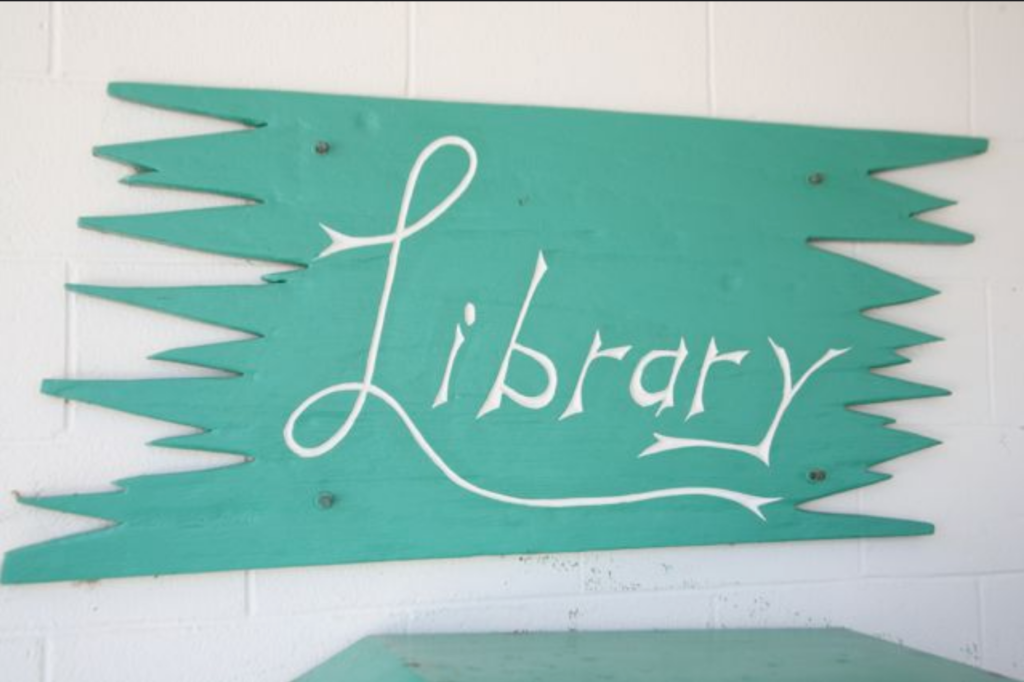
Every year the Curry County Government had been giving money to each of the County’s three libraries for them to operate with. A plan was developed among the three libraries for the other two libraries to donate some of their county funds to Port Orford for one year, if Port Orford would reimburse them the following year.
The City’s First Water Treatment Plant
The City’s water was chlorinated, but otherwise untreated. Our City received a grant for a water treatment plant. It was built next the Old Mill Pond. A part of that project included dredging part of the Mill Pond and installing a standpipe for the Fire Department to use as a backup source of water in an emergency. While dredging the Mill Pond, a lot of valuable Port Orford Cedar ‘sinker’ logs left behind from Mayor Gable’s TransPacific Lumber Company were recovered and traded with Tucker’s Sawmill in Langlois for lumber used to build a new City Shop building at the base of Hensley Hill.
A New Water Reservoir
The City had only one reservoir in town. It was small, uncovered and quite old having been built during the Great Depression in 1935 when Mayor Gable obtained a Works Public Administration grant for its construction. The only other reservoir nearby was a small, elevated wooden water tank on the Heads at the end of Coast Guard Hill Road. It had been built by the Coast Guard also during the Great Depression to serve the Lifeboat Station crew’s quarters and a couple of houses in ‘Little America’ for the officer’s families.
Port Orford had been needing to modernize its water system for years but never had the money. Coincidentally, I became aware the Port District’s Cannery could hire more people if the City could provide enough water for them to operate a hydraulic shrimp processor. The Port qualified for job-related grants for the equipment. Given our local unemployment situation, the City was also qualified to apply for Federal help, we just needed to come up with 50%. The City and the Port decided to coordinate our grant applications and give it a try. We still needed to come up with that 50% for the Federal match, but with a bit of persuasion the County agreed to give Port Orford the money we needed.
It helped that year was one of the rare years when Curry County received a large amount of the money from the sale of timber from Federally-own timberlands located in Curry County. The timberlands are referred to as ‘O&C’ (Oregon and California) timberlands, and the payments considered to be ‘in lieu’ of property taxes. Many other counties around the nation were receiving similar payments as well. The Curry County Commissioners would then distribute the money to fund various projects and fund the County Government.
I was pleased to see that soon as we had our modern water tank installed on Coast Guard Hill, there were many benefits for the City. For one thing insurance underwriters re-rated the City’s fire risk because all that additional water in storage made our City more fire resistant. The re-rating lowered everyone’s fire insurance costs. Another was that with more water in storage and greatly improved water pressure, people were finally going to be able to develop their valuable Coast Guard Hill properties into homesites. I knew this would eventually be a big boost to the City’s tax base.
Public Spaces
BUFFINGTON CITY PARK: On behalf of the City, I accepted a large piece of property from a com-bined project by the Buffington Family and the Port Orford Lions Club. With streets on two sides, it is very accessible and has been named as the Buffington City Park. Over the years the City has improved the park with a picnic area, a baseball field, lighted tennis courts, basketball backboard, miniature golf, nature trail, horse arena, and skateboard park.
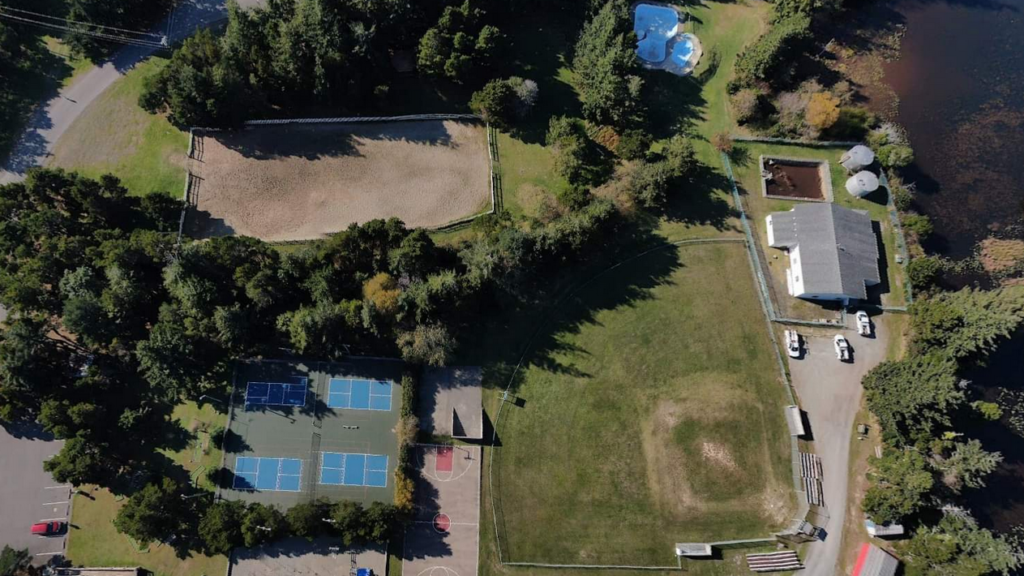
PORT ORFORD HEADS STATE PARK: The Oregon State Parks Department approached the City for its support in upgrading their Port Orford Heads Wayside into a State Park. The property had picnic areas, panoramic ocean views, nature trails, and historic 1934 Coast Guard Buildings. The City Council and I enthusiastically said “Yes”, we support it. This agrees with Oregon’s long time position that the enjoyment of all of Oregon’s beaches and State Parks should be protected and remain open to everyone, rich, poor, or in between.
PORT ORFORD COMMUNITY CENTER: For some time there had been a need for a place people and organizations could rent for their gatherings and events such as the annual Christmas Bazaar. That’s when the Port Orford Community Center with its stage at the south end was funded through private donations. I supported it as Mayor and then recall being asked to turn the first shovel of dirt to begin its construction.
Benj. Franklin Mobile S&L Service
While Mayor, I became aware of an article in Oregonian newspaper that mentioned the Benj. Franklin Savings & Loan was considering introducing mobile branch banking to the Oregon South Coast. Their plan was to serve Gold Beach, Port Orford and Bandon with a converted motor home. They were searching for the right community to be their home base. With interest rates spiking around 12-15%, those were very stressful times for everyone. Since I was always in favor of encouraging new businesses to locate in Port Orford, I reached out and offered my support.

I don’t recall now if they responded back, but it wasn’t long after they purchased the property south of what is now the Quilters’ Corner. They built a free-standing lobby facing Hwy. 101 with a drive-up lane behind, right outside the south wall of the Quilters Corner. The drive-up lane was where the mobile bank parked. It was quite innovative. I found it encouraging that their Manager bought a home in Port Orford and hired local people for his staff.
Similar free-standing bank lobbies were built in Gold Beach and Bandon. After the Savings & Loan was put into receivership in 1990, those buildings were purchased by other financial institutions and extensively remodeled. They remain in use today: Rogue Credit Union in Gold Beach and Bank of America in Bandon. In Port Orford, the Happy Tails Pet Supplies occupied the third building until 2022.
The Manager’s home in Port Orford was then purchased by Robert Reinhardt, a retired aerospace Field Engineer. After his passing in 1999, 50% of the proceeds from the sale of his home established a Rotary Scholarship Fund, with the remaining 50% given to help build Port Orford’s new Library.
Port Orford’s Bicentennial Mayor
July 4, 1976, was our nation’s bicentennial, and there I was, happy to be the City’s Bicentennial Mayor. In addition to celebrating Independence Day, each 4th of July Port Orford celebrates the construction in 1962 of a Jetty to protect the Port’s dock. Without the dock, the town’s commercial fishing fleet would have had to relocate to another port. 1962 is when Port Orford’s Independence Day celebrations had been re-named the ‘Jetty Jubilee’ Celebrations. The day’s grand finale would continue to be our Independence Day Fireworks, a brilliant spectacle launched from the beach by Port Orford’s Volunteer Fire Department into the night sky, lighting up the breaking surf below.
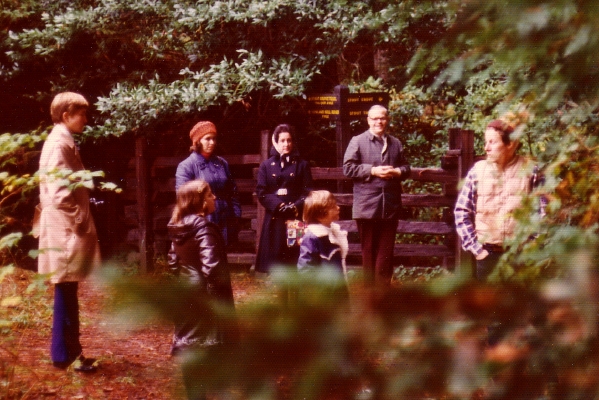
If I had ever been asked, I would never have guessed the time would come when I was Mayor of the City of Port Orford. Some of my High School classmates predicted otherwise in our class yearbook. When I graduated in the class of 1955 from Port Orford High School, a group of students had imagined a range of futures for each of the 20 graduates. These prophesies took into account each student’s aptitude’s and inter-ests, then projected them into some fantastic future – such as winning the Kentucky Derby. Their prophesy for me was I would be Mayor of Port Orford. I recall my puzzlement because I never imagined such a thing would happen.
The Gilbert E. Gable Council Chambers
Long before I was ever Mayor, it had occurred to me Port Orford had never done anything to honor or even remember the man who during the Great Depression had created so many for the town’s residents. That same man – Gilbert Gable – then helped our town incorporate as a City in 1935. Here I was, 37 years later and our City had not even named a street after him!
Before I became Mayor, the City had constructed a large space for a future City Council chamber. The room was empty. It had windows and doors, but no ceiling, wiring and sheetrock. There was no money to finish the project. Unknown to me, Alan Mitchell was also concerned that Gilbert Gable’s generous efforts for Port Orford during the Great Depression were going unrecognized.

Soon after I became Mayor, while Alan and I were discussing the historical importance of Gilbert Gable to the creation and development of the City, he asked what would happen if we reached out to the Gable Family for help in finishing the Council Chambers. I knew it was common in other cities for people to donate to a building in return for its naming rights. I mentioned to Alan that Gilbert Gable’s son Bob had lived his early years in Port Orford. Could there be a chance he might be interested in helping us honor the memory of his Dad? Coincidentally in the room with us was Bob Gable’s child-sized rolltop desk. It had been given to my father when Bob Gable’s family re-turned to Stearns, Kentucky following Gilbert Gable’s death in 1941.
Thinking ‘out of the box’, Alan wondered if Bob might be interested in reuniting with his childhood desk while providing Port Orford with the means to honor and remember Port Orford’s first Mayor – his Dad. I thought it wouldn’t hurt to find out, so I asked Alan to reach out to him. The thought occurred to me that if we succeeded, it would be like Port Orford winning the ‘Kentucky Derby’!

Bob Gable had been recently mentioned in a Wall St. Journal as being Kentucky’s Republican gubernatorial nominee. When Alan reached out to him, we got an enthusiastic “Yes” for an answer. Bob suggested the City obtain a contractor’s bid so he would know exactly how much money would be needed. The contractor who was awarded the job was Port Orford High School’s woodshop teacher, Glen Kadelbach.
Dedication Day was November 8th, 1976. The day before, the Gable Family had been greeted at the North Bend airport by Port Orford High School’s band and their teacher, Mike Malakowski.

The day of the Dedication we had a standing room only crowd. In addition to former Mayors, Councilmembers, Recorders, and employees, there were many of the town’s senior citizens who had known or worked for Gilbert Gable during their younger years. They were there to renew old friendships and greet, honor and thank the Gable Family.
During his years in Port Orford during the Great Depression, Gilbert Gable had many accomplishments as a private citizen and then ultimately served as our first Mayor. Behind where today’s Mayor sits in the Council Chambers is a large professionally made black & white photo of a then 50 year old Gilbert Gable. “Mayor Gilbert E. Gable Council Chambers” is the inscription above it.



Retired Port Orford Grade School teacher Margaret Meyers had known the Gables (Mayor Gable had upgraded the lighting system in Port Orford’s old two-story Grade School building where a young Margaret Meyers was teaching). Margaret wrote up a biography of Gilbert Gable to present at the Dedication Ceremony. The following are few paragraphs from it:
“In 1935, he moved his family to Port Orford and brought a quarter of million dollars to develop his plans. Within a year he had raised a sawmill, blown half a million tons of rock from Graveyard Point to form a five-hundred foot long breakwater dock, constructed an Administration Building to headquarter his companies, and built thirty homes to form a new section of Port Orford called the Hamlet. [Many of the homes he built in the Hamlet are still in use today.]
On Labor Day, 1935, the dock was formally opened with Governor Martin, Secretary of State Snell, and two thousand Oregon residents attending the dedication. That night a message from the President was written in fireworks: “Prosperity depends largely on private industry. Congratulations to Port Orford. Franklin D. Roosevelt”
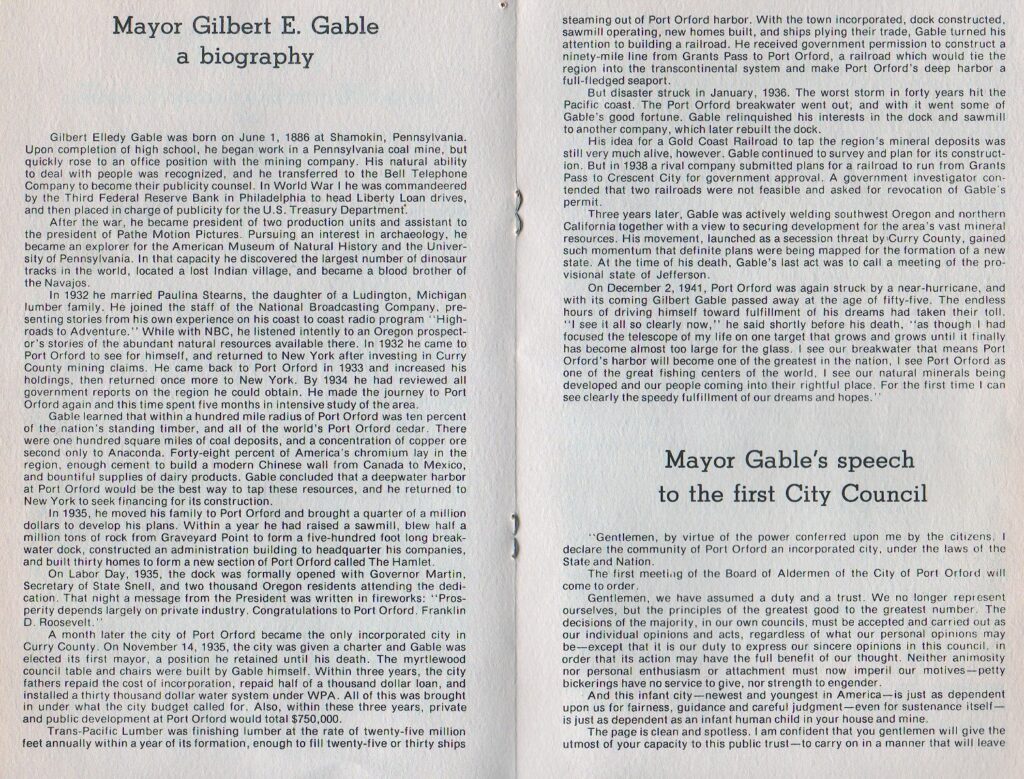


Mayor Gable used the rockblasted off part of Graveyard Point to build a dock for exports. Unfortunately, the jetty he built to protect the dock quickly failed beca use the rock used proved unsuitable. The dock lasted for a number of years, benefitting our commercial fishermen.
A month later the city of Port Orford became the only incorporated city in Curry County. On November 14, 1936, the city was given a charter and Gable was elected its first mayor, a position he retained until his death. The myrtlewood council table and chairs were likely to be designed by Gable himself. Within three years the city fathers repaid the cost of incorporation, repaid half of a thousand dollar loan, and installed a thirty thousand dollar water system under WPA. All of this was brought in under what the city budget called for. Also, within these three years, private and public development at Port Orford would total $750,000.

TransPacific Lumber was finishing lumber at the rate of twenty-five million board feet within a year of its formation, enough to fill twenty-five or thirty ships steaming out of Port Orford harbor. With the town incorporated, dock constructed, sawmill operating, new homes built, and ships plying their trade, Gable turned his attention to building a railroad. He received government permission to construct a ninety-mile line from Grants Pass to Port Orford, a railroad which would tie the region into a transcontinental system and make Port Orford’s deep harbor a full-fledged seaport.”
MARGARET MEYERS, RETIRED TEACHER/BIOGRAPHER
I was too young to remember him but I learned all about his many accomplishments as I was growing up. Among other things he had built a huge sawmill in what is now Buffington Park. The company was TransPacific Lumber and exported lumber and Port Orford Cedar logs to Japan. My father had worked there as a millwright.
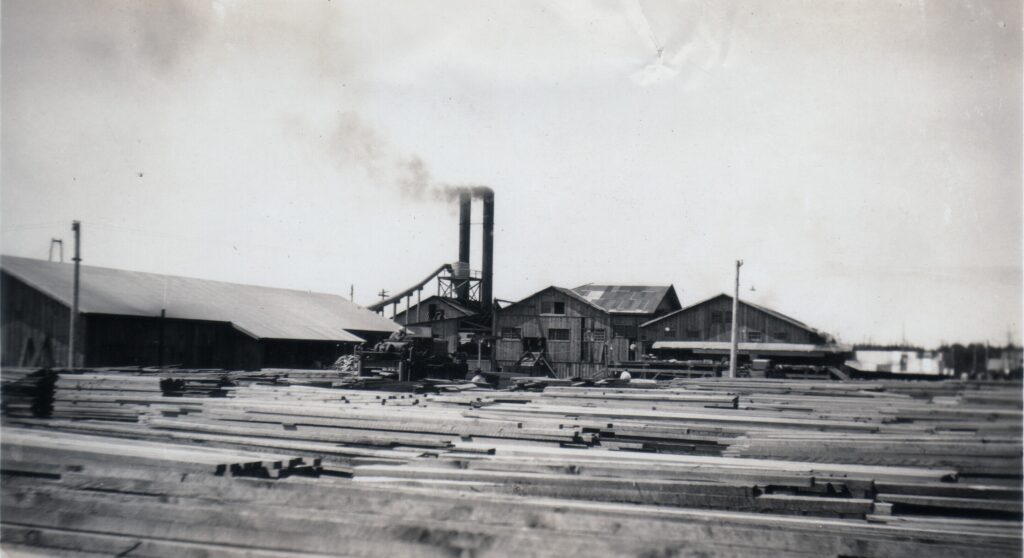
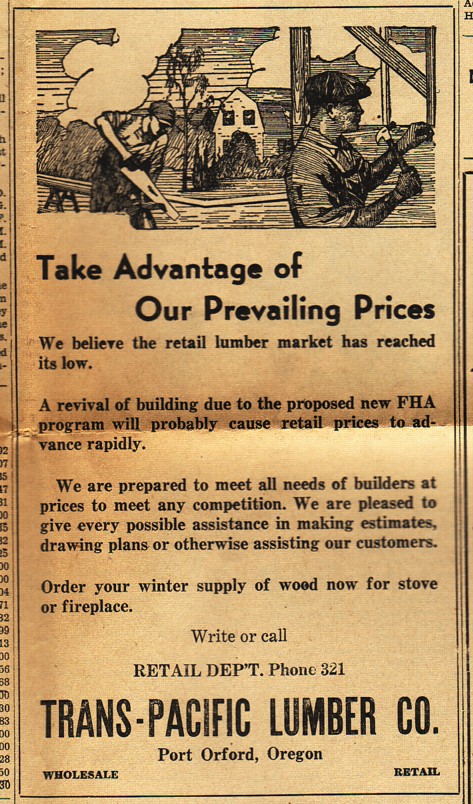
Mayor Gable’s Oregon Engineering Corporation purchased the bankrupt Inman Mine Company on Sixes River at a 1933 sheriff’s sale. “They had twelve cabins, a small sawmill and a blacksmith shop. Mayor Gable’s Oregon Engineering Corporation purchased the bankrupt Inman Mine Company on Sixes River at a 1933 sheriff’s sale. “They had twelve cabins, a small sawmill and a blacksmith shop. Altogether they had 30 unpatented mining claims and 80 acres of patented land.” (J.E.Morrison – June 10, 1939), Mayor Gable hired local men to reopen it. Among the ‘oldtimers’ in attendance at the Dedication were some of those men: Aerial MacDonald, Bill Nutt, Calvin ‘Dolly’ Smith and Ed Conley.


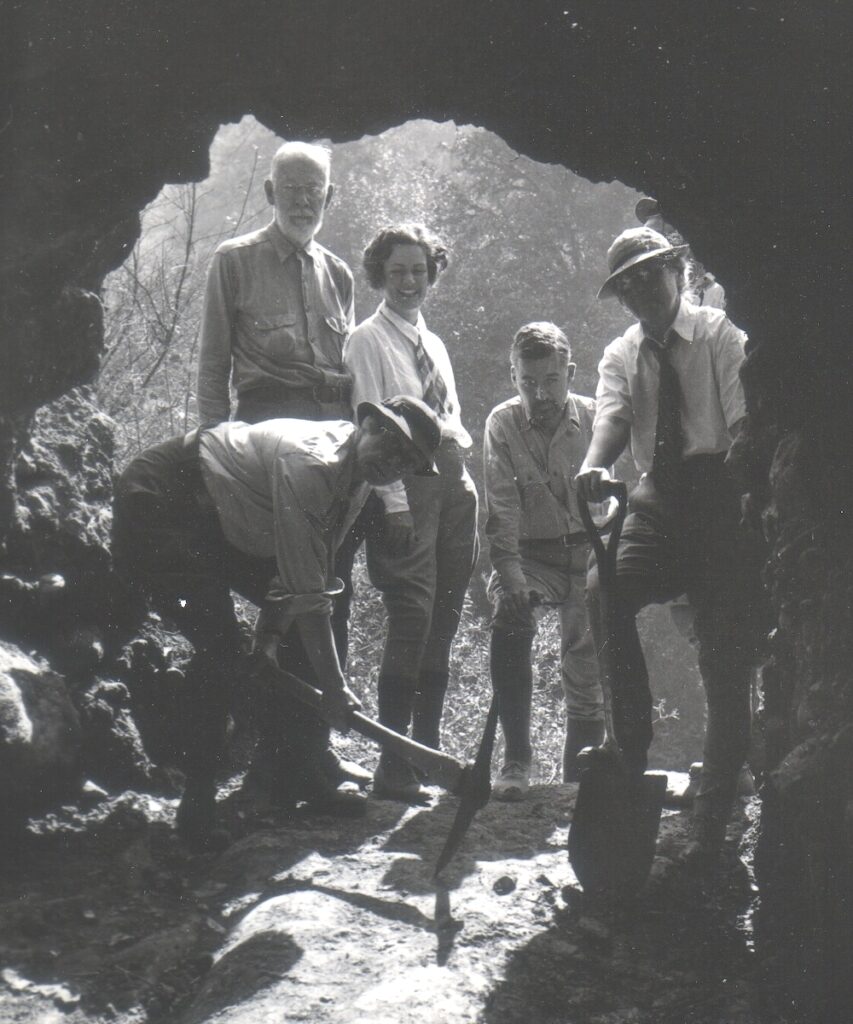



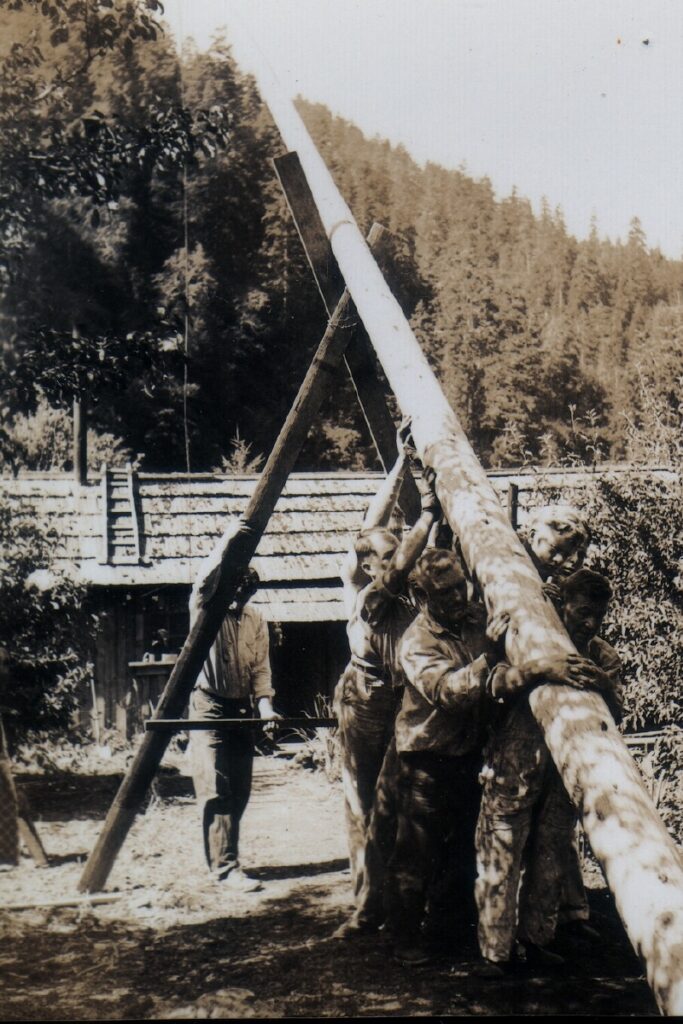


Everything suddenly came to an end, December 2nd, 1941, when Mayor Gable died of a heart attack. Five days later, America was attacked at our big Pacific Naval Station – Pearl Harbor, Hawaii.
The City of Port Orford has continued on. Even today, our Community remembers and honors Gilbert E. Gable for all he did for Port Orford. Practically single-handedly, he brought prosperity to the town’s residents during the darkest years of America’s worst economic Depression.


Ted longton
I’m Ted longton, son of the late vernita longton and dad was Edward Joseph longton, he was a shareholder of western state plywood. My dad help build Port Orford’s first community church in the late 50s
.
admin
Hi Ted — Welcome aboard! We would love to learn more about your family history. If you have materials you would like to contribute to the project, you can learn more here: https://blog.portorfordhistoricalphotos.org/participate/